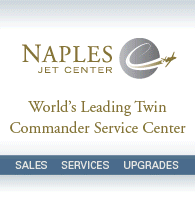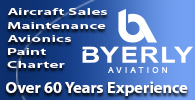The aviation world, and the Twin Commander community have lost two of their brightest stars. Robert A. “Bob” Hoover, who Jimmy Doolittle called the best stick-and-rudder pilot who ever lived, and Arnold Palmer, perhaps the world’s best-known owner-pilot, each had a special relationship with Twin Commanders. Palmer flew two different models of Aero Commanders early in his career as a professional golfer, and Hoover, of course, thrilled airshow audiences for years with his precision aerobatic performances flown in his virtually stock Shrike Commander.
A PILOT WHO GOLFED

Arnold Palmer, who once said he probably would have been a professional pilot if he hadn’t succeeded so spectacularly in golf, grew up about a mile from the airport in Latrobe, Pennsylvania, and liked to spend time there listening to the stories spun by the local pilots. His first airplane ride was in a Piper Cub, and it sparked a desire to learn to fly.
He acted on the desire after he and his wife Winnie had spent the first years on the pro golf tour driving to tournaments with a travel trailer in tow. In his early flying days Palmer trained in various Cessna singles. “After I got down the basics, I had the thrill of my first solo flight—a spin over the Allegheny Mountains, during which I felt the power of having the controls of the airplane entirely to myself,” he said. He earned his Private certificate in 1956, and soon began work on adding instrument and multiengine ratings.
In 1958 he won the Master’s, then leased a Cessna 175 and hired a pilot to fly with him to events. He also chartered aircraft. “If it were a long trip, I would use a twin-engine like an Aero Commander,” Palmer said.
He bought his first plane, an Aero Commander 500, in 1961.
“I liked the thought of having a twin-engine, and it was the best buy around,” he said. “It was a repossessed airplane. It worked very well for me. I flew everywhere.”
In 1963 he upgraded to a new Aero Commander 560F. “It had a cruising range that would enable us to make it to Palm Springs from Latrobe with just one stop, cruising at 240 nautical miles per hour,” Palmer said.
In 1966 he acquired what he called his “latest capitalist tool,” a Rockwell Jet Commander. In so doing he became the first professional athlete to own and fly a jet. Palmer continued to own and fly his own jets long after he retired from competitive professional golf. He made his last flight as pilot-in-command on January 31, 2011—the day his aviation medical certificate expired—flying his Cessna Citation X from Palm Springs to Orlando. He was 81.
A decade earlier, Palmer commented on the central role that flying had played in his life. “To put it quite simply, I could never have accomplished even half as much as I have in my golf and business careers over the last four decades without having my own airplanes,” he said.
THE PILOT’S PILOT

Nashville native Bob Hoover grew up in the Golden Age of aviation, and one day would become as famous as many of the pilots of that era. He was five when Charles Lindbergh made his nonstop trans-Atlantic solo flight in “Spirit of St. Louis,” and was profoundly influenced by it. He began constructing model airplanes, and read everything he could about flying. He worked at a grocery store to earn money for flying lessons at Berry Field, soloing in a Taylor E-2 at age 16.
Hoover joined the Tennessee National Guard in 1940 as a tail-gunner trainee, and passed the test for Army Air Corps flight training. Despite his 6-foot-2-inch height he was assigned to fly single-seat fighters, and set out to become the “greatest fighter pilot who ever lived.” What followed was a series of harrowing escapes from accidents and near-catastrophes, including being shot down in a Supermarine Spitfire after scoring his first combat kill. After 16 months in a German prison camp, he escaped by stealing a Focke-Wulf Fw 190. A combination of great good luck and consummate innate talent and skill meant he survived those brushes with mortality, all of which contributed to his ability to control an aircraft—any aircraft—in any axis, any configuration, and seemingly in any state of distress.
Later during the war he was assigned to evaluate aircraft delivered to bases in North Africa, including the new Lockheed P-38. To demonstrate the controllability and capability of the unusual twin-engine, twin-boom fighter he developed a stunning low-level aerobatic routine. It would serve as the basis for his later public demonstration flights in an Aero Commander.
Back in the U.S., Hoover signed up to fly the Bell X-1, the experimental rocket-powered aircraft built to break Mach 1, the speed of sound. Hoover was said to be the top choice—until the Colonel in charge of the flight test division learned that Hoover had flown a P-80 Shooting Star upside down at low level across the Springfield, Illinois, airport a few months earlier. Hoover was named backup pilot to Chuck Yeager, and had to spend the time with the program flying a chase plane and photographing Yeager in the X-1.
Following his military service he began working for North American Aviation, based at Los Angeles International Airport, a relationship that lasted for 36 years. Initially he was an engineering test pilot, evaluating the company’s series of military designs—the T-28 Trojan, FJ-2 Fury, AJ-1 Savage, F-86 Sabre and F-100 Super Sabre. Later he was appointed director of customer relations and assistant to the marketing director. He was told he could continue to fly any aircraft manufactured by North American.
HOOVER’S COMMANDER
In the mid-1950s Hoover began flying civil and military aircraft at various air shows. A decade later, shortly after the 1968 merger between North American Aviation and Rockwell, he was sent to Oklahoma City to evaluate Rockwell’s Aero Commander division. While touring the manufacturing operations, he saw dozens of unsold aircraft on the ramp. “Rockwell had acres of them,” he said. “They were building one a month and losing $13 million a year.”
When Dick Robinson, vice president of sales and later president of the division, asked Hoover if he could develop an aerobatic routine that would bring positive attention to Commanders, Hoover thought back to the demonstration routine he had performed in the P-38.
“The key was to see whether I could perform the P-38 maneuvers within the structural design limits of the Aero Commander,” he said. “The P-38 was a fighter capable of pulling 7.33 Gs, whereas the Shrike Commander…was limited to 4.4 as a utility design.”
His first public demonstration was flown at the Reading, Pennsylvania, Air Show. Soon, he was in high demand at air shows around the country. “Once those performances demonstrated the Shrike’s capability, production increased from one a month, to two, and then eventually to eight,” Hoover said.
In 1973 he began flying N500RA, a 500S Shrike modified with smoke and propeller unfeathering systems. Because it was a stock business aircraft, Hoover felt the Shrike was more of a challenge to fly in air show performances than his P-51 Mustang. His routine highlighted the Shrike’s excellent high- and low-speed handling capabilities, and its one-engine and no-engine performance. Along with loops and 16-point rolls, Hoover performed his signature engine-out maneuvers—a loop; an eight-point roll; a 180-degree turn to a dancing touchdown, first with one wheel and then the opposite wheel; followed by the landing and engine-out taxi to air show center.
Hoover also was filmed performing a roll while pouring iced tea into a glass sitting on top of the instrument panel, and not spilling a drop.
Long-time Commander salesman Bob Mays, who was profiled in the Spring 2010 issue of Flight Levels, first met Bob Hoover in Korea, where Mays was flying North American F-86s. Hoover was there to demonstrate the F-86’s manual pipper control for targeting. “When Hoover arrived I said, ‘Mr. Hoover can I pick out a good airplane for you to fly?’ ” Mays remembers. “‘No, that’s alright, I’ll just take this one,’ he said. Then he proceeded to take off and go right into a loop with the gear and flaps down. Well, like all fighter pilots we thought we were the greatest pilots who ever lived,” Mays says. “But when we saw Hoover do that we thought, Holy Mackerel, it’s time to turn in our wings.”

Bob Mays (left) with his wife, Janet, at an awards ceremony being congratulated by life-long friend, Bob Hoover.
Mays and Hoover became friends for life. “He was a wonderful gentleman, a super human being, and the best stick and rudder guy ever,” Mays says.
Hoover’s last flight in N500RA was in October 2003, when he and a ferry pilot flew it from Lakeland, Florida, to the Smithsonian Institution’s Steven F. Udvar-Hazy Center at Dulles International Airport. Hoover taxied the airplane onto the museum floor—the only pilot ever allowed to do so—where it is on permanent display.
A Celebration of Hoover’s Life was held November 18 at Clay Lacy Aviation at Van Nuys Airport in Los Angeles.




